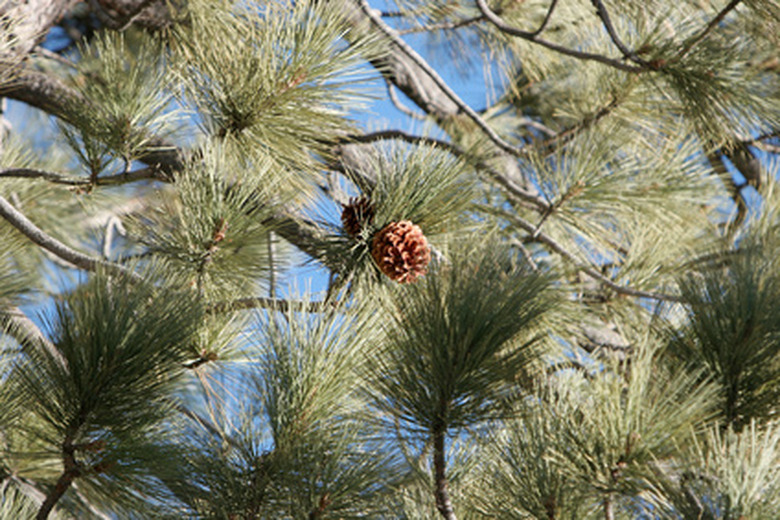How To Graft Pine Trees
Things Needed
- Pruning shears
- Plastic freezer bag
- Water
- Grafting knife
- Grafting chisel
- Mallet
- Polyethylene grafting tape
- Asphalt water emulsion compound
Most trees that are grafted are hybrid trees; they do not reproduce seedlings that are exactly the same as their parent trees. But there are a handful of reasons for grafting a pine tree. Reasons for grafting pine trees range from filling in bare spots on ornamental or Christmas trees to creating trees that are more disease-resistant or that have accelerated breeding cycles. Several different grafts are suitable for grafting pine trees.
Collecting Scions
Step 1
Cut a scion from a pine tree that is less than 5 years old.
Step 2
Position the pruning shears at a spot on a branch that is 6 inches from the end of the limb.
Step 3
Cut the scion away from the limb by making a slice crosswise to the limb.
- Most trees that are grafted are hybrid trees; they do not reproduce seedlings that are exactly the same as their parent trees.
- Reasons for grafting pine trees range from filling in bare spots on ornamental or Christmas trees to creating trees that are more disease-resistant or that have accelerated breeding cycles.
Step 4
Place the scion in a plastic freezer bag with 1 tbsp. of water. Put the bag in a refrigerator at 40 degrees Fahrenheit. Store the scion through the winter.
Step 5
Graft the scion onto a pine tree's trunk, known as the rootstock, in early spring, using one of the methods below.
Whip Graft
Step 1
Cut the bottom of the scion so that the cut end makes an angle that is approximately 1-½ inches long.
Step 2
Cut a tongue into the scion about halfway up the slice made in Step 1, using a draw cut, which is a single cut with a grafting knife. Carefully control the cut so that the branch does not split under the pressure. Pull the blade down the center of the branch to a point that is even with the start of the cut in Step 1.
- Place the scion in a plastic freezer bag with 1 tbsp.
- Cut a tongue into the scion about halfway up the slice made in Step 1, using a draw cut, which is a single cut with a grafting knife.
Step 3
Make an identical set of cuts into the rootstock tree's trunk or branch. Make cuts in the rootstock that mirror the cuts in the scion so that the two pieces fit together like pieces of a puzzle. The trunk or branch of the rootstock should be the same size as the scion branch.
Step 4
Press the scion onto the rootstock. Make sure that the bark layer of the scion and rootstock touch. Bind the two parts together with polyethylene grafting tape.
Step 5
Remove the tape in a few weeks when the scion and rootstock heal together.
- Make an identical set of cuts into the rootstock tree's trunk or branch.
- Make cuts in the rootstock that mirror the cuts in the scion so that the two pieces fit together like pieces of a puzzle.
Cleft Graft
Step 1
Cut the end of the scion to a blunt point in which one side of the point is thicker than the other.
Step 2
Remove a thick branch or the top of a pine tree with a saw.
Step 3
Create a cleft in the exposed rootstock cut with a clefting chisel. Do not allow the bark to split at the ends of the cleft.
Step 4
Slip the blunt point of the scion into the cleft. Ensure that the bark of the rootstock and scion touch.
Step 5
Cover the union between the scion and rootstock with asphalt water emulsion compound.
- Cut the end of the scion to a blunt point in which one side of the point is thicker than the other.
- Create a cleft in the exposed rootstock cut with a clefting chisel.
Side Graft
Step 1
Cut the end of the scion to a blunt point in which one side of the point is thicker than the other.
Step 2
Select a smooth portion of a rootstock branch located at least a foot from the trunk of the pine tree.
Step 3
Make a slanting cut at an angle that extends almost to the core of the tree branch.
Step 4
Bend the rootstock branch back and insert the scion limb into the cut. Ensure that the bark of the scion and rootstock limb touch. Wrap the bark with polyethylene grafting tape to secure the union and keep it from drying until the union heals.
Step 5
Remove the tape when the union heals. Remove the rootstock limb at a point beyond the graft.
- Cut the end of the scion to a blunt point in which one side of the point is thicker than the other.
- Remove the rootstock limb at a point beyond the graft.
